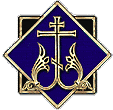Difference between revisions of "Taraskovyan Orthodox Church"
m (Categorised.) |
|||
| Line 93: | Line 93: | ||
* Uthar | * Uthar | ||
* Vishna | * Vishna | ||
| + | |||
| + | [Category:Tarasovka] | ||
| + | [Category:Religions] | ||
Revision as of 20:53, 21 May 2005
| Taraskovyan Orthodox Church Vigvar Patriarchate | ||||||
|---|---|---|---|---|---|---|
|
| ||||||
|
Approximately 70% of the Taraskovyan population declare themselves as belonging to Eastern Orthodoxy. And the near entirety of those declare themselves as belonging to the Taraskovyan Orthodox Church, or the Vigvar Patriarchate as it is both official called and commonly referred to by the Taraskovyan population.
Contents
History of the Vigvar Patriarchate
The first roots of Christian faith in Tarasovka go back to the slaves that were brought in massively from beyond the oceans by Taraskath merchants. Being pagans at first, the slave labour force begun to slowly Christianize itself as more and more Christian slaves were brought in. The Taraskath leadership, as well as the Church of the Seven Deities, paid no attention to the proselytizing of the slaves and never did anything to hinder it.
After the end of the Strife, the advent of Mstislav Shakhovskoy, himself a Christian at first, and the abolition of slavery, Christianity was free to blossom throughout the country. The Christian community came under the jurisdiction of the Bishop of Constantinople and, with the break up of the Christian Church, remained loyal to the Eastern Rite.
Due to the fact that the overwhelming majority of the Taraskovyan Orthodox were of Russian Origin, Tarasovka quickly became an eparchy under the authority of the Metropolite of Moscow, who, by that time already, was de facto independent from the Patriarch of Constantinople.
As more and more Russian migrants arrived to Tarasovka, the Vigvar Eparchy was transformed into an Exarchate of the Russian Orthodox Church in 589 A.S. But as the influence of the Metropolite of Vigvar and all Taraskovya began to grow, so did the calls for autocephaly. And so, in 781 A.S., upon consensual agreement between the Moscow Patriarchy and the Exarchate of Vigvar, the Vigvar Patriarchate was created. The year of the achieving of autocephaly is considered to be the year of the founding of the Taraskovyan Orthodox Church, or the Vigvar Patriarchate as it is officially called.
Canonical Structure
Branches of Power
Patriarch
The Patriarch is the supreme authority of the Taraskovyan Orthodox Church. Elected for life by the Council of Archierei, he is aided in his task by the Holy Synod of the Vigvar Patriarchate.
At this time, the head of the Taraskovyan Orthodox Church is His Holiness Patriarch Nikon II of Vigvar and all Taraskovya.
Holy Synod
The Holy Synod of the Patriarchate is an equivalent of a Chancellery to the Patriarch, to which the latter delegates a number of his daily tasks. The Holy Synod consists of nine members, all of whom are appointed by the Patriarch.
Four of the members of the Holy Synod are permanent:
- Mitropolite of Uthar (Patriarchal Exarch to South Cardinia and Uthar) at this time His Eminence Mitropolite Dimitry of Uthar
- Metropolite of Bogatyr, at this time His Eminence Mitropolite Alexy of Bogatyr
- Metropolite of Arkhangelsk, at this time His Eminence Mitropolite Innokentiy of Arkhangelsk
- Head of the Office for External Relations, at this time His Eminence Mitropolite Kirill of Tin-Vilena and Tal-Nathil
The other five members are appointed by the Patriarch for a period of two years after which they are replaced.
Council of Archierei
The administrative body that reunites all of the Archierei of the Taraskovyan Orthodox Church and decides on most of the matters of the Church, including such important matters as electing the Patriarch or deciding on canonization.
In the Taraskovyan Orthodox Church, the rank of Archiereus is subdivided into Episcop(Bishop), Archiespiscop(Archbishop) or Metropolite. A Metropolite is an Archiereus entrusted with the leadership over an Eparchy, whilst the Archiepiscops and Episcops often serve as vicars.
High Court of the Church
This institution dedicates itself to examining the crimes of priests as well as resolving any disputes that are not in the competence of the Holy Synod or of the Council of Archierei. Nowadays, this Court is greatly limited by the law-courts of the Taraskovyan state and is often reduced to carrying out administrative punishments of members of the Church that have violated Church or national laws.
Eparchies and Exarchate
An Eparchy is the equivalent of a Diocese in the Eastern Orthodox Church, led by an Archiereus (a Metropolite in the Taraskovyan Orthodox Church). The Vigvar Patriarchate counts the following Eparchies:
- Amal and Vigvar
- Bogatyr
- Uith (comprising the Fiefdoms of Uith and Kshas-Uith)
- Arkhangelsk and Namel-Cardin (comprising the Fiefdoms of Tal-Nathir and Northern Cardinia)
- Keth
- Cardin
- Kem
- Elista
- Vladizapad (comprising the Fiefdoms of Zapadozemie and Novozemie)
- Kharit
- Srednegrad
- Shek’Tarad
- Seth (comprising the Fiefdoms of Zerth, Setar and Uil)
- Tin-Vilena and Tal-Nathil
- Var-Vilena
- Zlatograd
During the times when the Vortex Corporation was an independent state, many Taraskovyan Orthodox settled in the nation, which led the Vigvar Patriarchate to create the Exarchate of South Cardinia and Uthar. The Exarchate enjoyed a greater deal of autonomy than the eparchies in Tarasovka, however, when the Vortex Corporation was absorbed by the Taraskovyan Federation, the Exarchate found itself in the territory of the same nation in which the Patriarchate was. This has led the Council of Archierei to begin consultations on whether or not to upkeep the Exarchate’s status.
As of now, the Exarchate consists of the following Eparchies:
- Crayven
- Uthar
- Vishna
[Category:Tarasovka] [Category:Religions]

